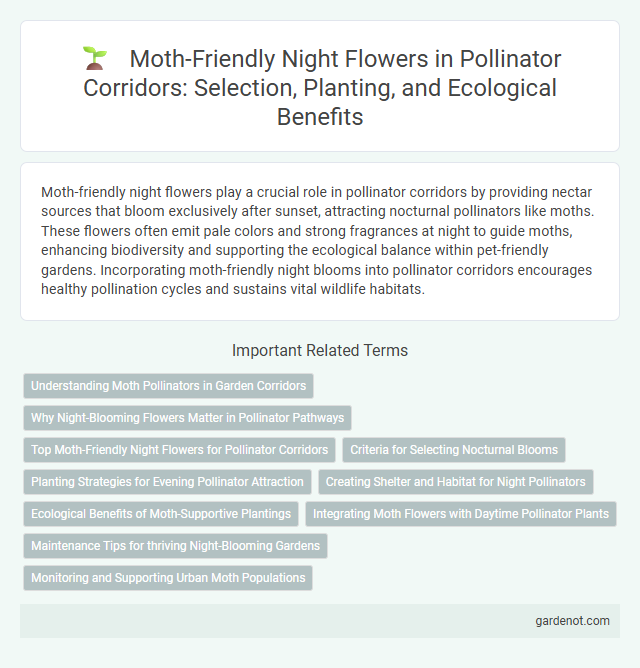Moth-friendly night flowers play a crucial role in pollinator corridors by providing nectar sources that bloom exclusively after sunset, attracting nocturnal pollinators like moths. These flowers often emit pale colors and strong fragrances at night to guide moths, enhancing biodiversity and supporting the ecological balance within pet-friendly gardens. Incorporating moth-friendly night blooms into pollinator corridors encourages healthy pollination cycles and sustains vital wildlife habitats.
Understanding Moth Pollinators in Garden Corridors
Moth-friendly night flowers such as evening primrose and night-blooming jasmine provide essential nectar sources for nocturnal moth pollinators within garden corridors. These moths, including species like hawk moths and owlet moths, play a crucial role in pollination by transferring pollen while feeding under low-light conditions. Creating a continuous pollinator corridor with diverse night-flowering plants supports moth populations, enhances biodiversity, and promotes healthy ecosystem functions.
Why Night-Blooming Flowers Matter in Pollinator Pathways
Night-blooming flowers play a crucial role in pollinator corridors by providing essential nectar sources for nocturnal pollinators such as moths and bats. These flowers emit strong fragrances and display pale or white colors that enhance visibility in low light, attracting pollinators active during nighttime. Incorporating moth-friendly plants into pollinator pathways supports biodiversity and helps maintain ecological balance by ensuring pollination occurs around the clock.
Top Moth-Friendly Night Flowers for Pollinator Corridors
Top moth-friendly night flowers ideal for pollinator corridors include Evening Primrose, Night-Blooming Jasmine, and Four O'Clocks, all known for their strong nocturnal fragrance and nectar-rich blooms that attract moths. These species play a critical role in supporting moth populations by providing essential food sources during their active nighttime hours. Integrating such night-blooming plants enhances biodiversity and promotes effective pollination within ecological corridors.
Criteria for Selecting Nocturnal Blooms
Selecting moth-friendly night flowers requires blossoms with strong, sweet fragrances emitted at night to attract nocturnal pollinators. Flowers should exhibit pale or white colors for enhanced visibility in low light and produce abundant, easily accessible nectar. Bloom timing aligned with moth activity and structural traits accommodating moth proboscises are essential for effective pollinator support.
Planting Strategies for Evening Pollinator Attraction
Selecting moth-friendly night flowers such as evening primrose and jasmine enhances pollinator corridors by providing nectar sources during nighttime. Strategically planting these nocturnal bloomers along corridors supports moth populations, which are vital night pollinators for many ecosystems. Incorporating scent-rich, pale-colored flowers increases visibility and attraction for moths, optimizing evening pollination.
Creating Shelter and Habitat for Night Pollinators
Moth-friendly night flowers provide essential shelter and habitat for nocturnal pollinators, supporting biodiversity and ecosystem health. These flowers offer resting places and protection from predators, enabling moths to thrive during nighttime pollination activities. Incorporating native night-blooming plants enhances habitat connectivity within pollinator corridors, promoting sustainable populations of moths and other night pollinators.
Ecological Benefits of Moth-Supportive Plantings
Moth-friendly night flowers enhance pollinator corridors by providing essential nectar sources during nighttime hours, supporting the feeding and reproductive cycles of diverse moth species. These plantings contribute to ecological balance by promoting pollination of nocturnal plants, increasing biodiversity, and sustaining food webs that include bats and other nocturnal predators. Incorporating moth-supportive plants in pollinator corridors strengthens ecosystem resilience and aids in the conservation of declining moth populations.
Integrating Moth Flowers with Daytime Pollinator Plants
Moth-friendly night flowers such as evening primrose and moonflower thrive alongside daytime pollinator plants like coneflowers and bee balm, creating a continuous habitat that supports diverse pollinators throughout a 24-hour cycle. Integrating these nocturnal blooms with sun-loving species enhances pollinator corridors by attracting both moths and diurnal insects, improving biodiversity and pollination efficiency. Strategic planting of moth-pollinated night flowers within daytime pollinator gardens fosters ecological balance and sustains vital pollination networks.
Maintenance Tips for thriving Night-Blooming Gardens
Night-blooming gardens designed to attract moths require regular pruning to remove spent flowers, which encourages continuous blooming and prevents disease. Maintaining moist, well-drained soil enriched with organic matter supports healthy root systems essential for night flowers like evening primrose and moonflower. Light trimming and avoiding harsh chemicals ensure a safe environment for nocturnal pollinators, promoting vibrant moth-friendly pollinator corridors.
Monitoring and Supporting Urban Moth Populations
Moth-friendly night flowers, such as evening primrose and moonflower, play a crucial role in sustaining urban moth populations by providing essential nectar sources during nocturnal hours. Monitoring these pollinator corridors through citizen science initiatives and light trap surveys enables researchers to track population trends and identify habitat needs. Supporting urban moths involves planting diverse native night-blooming flora and reducing artificial light pollution to enhance their foraging efficiency and reproductive success.
Moth-friendly night flower Infographic

 gardenot.com
gardenot.com